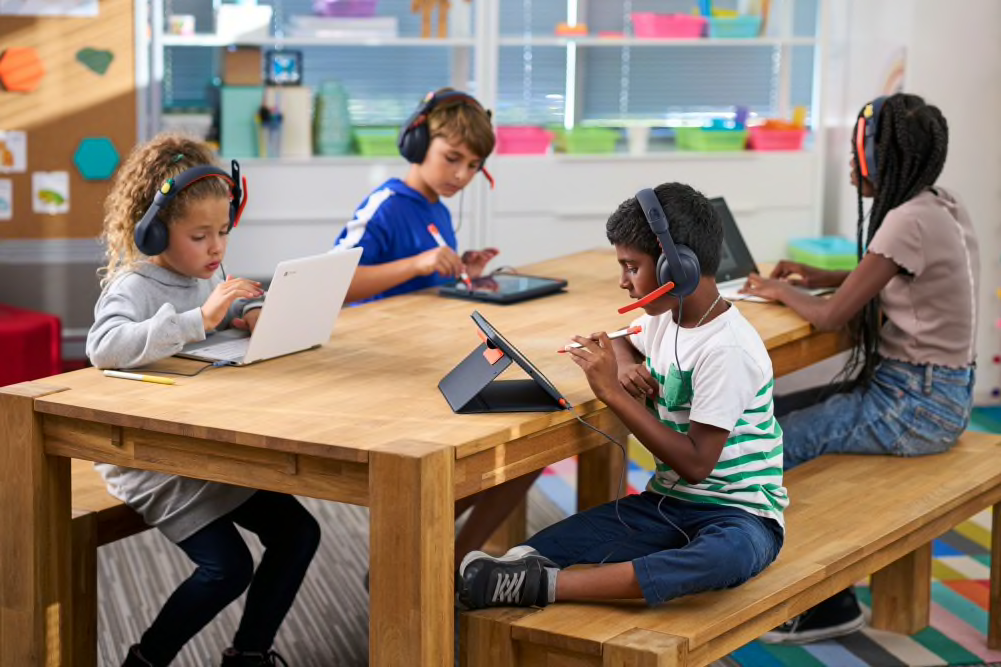The Secret to Classroom Focus: Good Audio
Explore how hearing plays a role in student focus and building strong relationships between teachers and students.

Hearing is people’s second favorite sense, but its importance in the classroom is sometimes muted.YouGov Omnibus poll. (July 2018). https://today.yougov.com/topics/health/articles-reports/2018/07/25/five-senses-majority-would-miss-sight-most Despite being undervalued, hearing plays a role in building strong relationships between teachers and students, keeping students focused, cognitive ability, and student success. By using a variety of strategies and technologies, district leaders and teachers can prioritize clear audio to make sure all students and educators can hear and be heard.
Help everyone in class hear
Noise levels in classrooms have a big impact on the productivity of learning environments. Researchers link excessive noise to serious health problems and problems with cognitive ability and academic performance.Too Loud! For Too Long! Center for Disease Control and Prevention. (January 2020). https://www.cdc.gov/vitalsigns/hearingloss/index.html#:~:text=Hearing%20loss%20causes%20many%20problems,home%20and%20in%20the%20community Thompson, R., Smith, R., Karim, Y., et al., (January 2022). Noise pollution and human cognition: An updated systematic review and meta-analysis of recent evidence. ScienceDirect. https://www.sciencedirect.com/science/article/pii/S0160412021005304
There are many ways educators can lower classroom noise pollution. One way is to introduce a “quiet noise” like a wind chime or rain stick that signals to students when it is time to be quiet. Older students may respond better to techniques like signal words related to content they are learning for the week.
Headsets are another effective way to diminish the impact of classroom noise. Logitech Zone Learn is tuned for learning and focuses on voice clarity. So, whether students are listening to an educator or educational app, they’ll hear every word. Designed for students, the headset has a headband with a soft comfort layer and foam-padded ear pads that create noise isolation and maximize comfort. The fit of the headsets works so well that in a Logitech study, 96% of students said they were “comfortable” or “very comfortable” wearing Zone Learn throughout an entire lesson period.
Help everyone in class be heard
Strong relationships between teachers and students improve student engagement and help them be active learners.Quin, D., et al. Longitudinal and Contextual Associations Between Teacher–Student Relationships and Student Engagement: A Systematic Review. Via Sage Journals. https://journals.sagepub.com/doi/abs/10.3102/0034654316669434 But when students and teachers can’t hear each other, their bond can be strained.
Providing students with different ways to express ideas, thinking, and answers can help ensure they are always heard. Strategies such as polls, mind mapping, or brainwriting are worth considering. These guided activities give students the opportunity to share. Younger students who yet have the cognitive skills needed for these activities can draw a picture first, then take turns sharing illustrations.
Amplifying the voices of students and teachers can help too. Many teachers say they often have to speak loudly so students can hear instructions, with 75% of them saying their voices are often hoarse and strained at the end of the day. The Yeti microphone gives educators studio-quality sound and easy-to-use controls to ensure their voices are projected clearly. For hybrid or remote learning environments, Logitech Rally Bar solutions come with auto-leveling for loud and soft voices – with AI-based RightSound technology that improves over time.
Students can also use microphones in small groups to produce high-quality projects like podcasts. Once recorded, classes can listen to recordings together, or teachers can create individual listening assignments. Class presentations are another way students can use microphones. By amplifying student speech, the Yeti can help learners overcome challenges with changing voices or with confidence in public speaking.
So much of learning depends on students and teachers being able to hear — hear each other, hear content, and hear educational apps. When educators minimize the impact of classroom noise, making specific sounds clearer and amplifying voices at the right moment, they create classrooms ready to embrace learning anywhere, anytime, and in any style.
YOU MAY ALSO BE INTERESTED IN
Let’s Talk
Learn more about how Logitech can help you shape the future of education.
Contact Sales
THANK YOU FOR CONTACTING US
A product expert will reach out to you shortly.